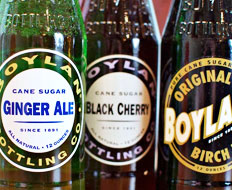Handcrafted. Natural. Artisan. Signature. These foodie buzzwords may have once described decadent pizzas or burgers featuring grass-fed beef, but they’re increasingly featured on the beverage side of quick-serve menus, too.
Freshness and originality are becoming increasingly important buying factors for today’s restaurant-goers, and operators have begun bolstering their drink programs with premium craft-soda options, which offer customers a more enhanced beverage experience than traditional mass-market picks.
“Customers are looking for things that seem like specialties—new, innovative options you can’t get everywhere,” says Maeve Webster, director at food industry market research firm Datassential. “We’re also seeing consistent demand for offerings that are local, small-batch, rare. Custom-soda programs are helping restaurants address these niche demands, and can be a real differentiator for Millennial buyers, who have endless choices.”
This new breed of craft sodas, which some industry experts believe is an alcohol-free outgrowth of the popular craft-beer movement, has several distinct characteristics. The sodas are made with cane sugar and other natural ingredients and are typically brewed in small, locally sourced batches. Craft soda also has the attention of health-conscious consumers, since they’re positioned as a more natural option to traditional sodas.
“Around 90 percent of restaurants currently have something on their menu categorized as ‘fresh,’ and it still resonates with customers,” Webster says. “The perception is that craft sodas are more exclusive and provide higher-quality experiences.”
For restaurants already emphasizing natural ingredients and original experiences, craft-soda programs are a natural fit. Take Live Basil, for example. The fast-casual pizza concept launched in Denver earlier this year with a focus on fresh options, and debuted with a Boylan craft-soda fountain to give customers a more diverse beverage selection. Products from Boylan Bottling Company, a small soda brand that was founded in 1891, are only available in 20 states, and the brand has a passionate grassroots following.
Despite having only been open for a few months, Live Basil has already seen excellent customer response for the Boylan fountain, and executives believe the sodas actively reaffirm the brand’s key messaging.
“Live Basil was conceived to meet the needs of the next generation of restaurant guests, with a focus on fresh, authentic food people can feel good about eating,” says Tom Ryan, Live Basil’s founder and chief concept officer. “Craft sodas really align with that message—they’re a premium offering with robust, natural flavors.”
Beverages are becoming an area of increasing importance for the fast-casual segment, Ryan adds, and should be leveraged as part of a concept’s overall branding efforts.
“Boylan sodas give Live Basil an added dimension. We make sure to mention them in our outreach and marketing materials, since that’s what customers are looking for,” he says. “We feel they give our brand more energy and new panache. I’ve actually sat in stores and watched customers taste each flavor.”
Perhaps most telling of the craft-soda trend’s staying power is the fact that Starbucks is now toying with the product. The coffee giant recently commissioned in-house research and development teams to create original recipes for its own proprietary line of sodas, which are now undergoing pilot testing at 150 stores in Atlanta and Austin, Texas. The sodas come in three retro flavors—a lemon ale, spiced root beer, and ginger ale—and are individually measured, mixed, and carbonated by baristas on the spot.
“Starbucks is known for custom beverages—our baristas make a variety of handcrafted, made-to-order coffee and tea drinks every day,” says Linda Mills, a spokeswoman for Starbucks. “Craft sodas seem like a natural extension for our refreshment platform, which inspired this concept testing. Our sodas are made with natural ingredients and are fairly low-calorie, so they’re something customers can feel good about drinking, too.”
While Mills says it’s still too early to tell when or if the Starbucks soda program will launch company-wide, initial response to the testing has been positive.
“Customers are really enjoying the sodas, and are even experimenting with carbonating some of our core beverages,” she says. “We’re very pleased with feedback to date and look forward to evaluating customer response as the test progresses.”
As more restaurants develop craft-soda options, experts say, the immediate industry implications are clear: Gone are the days when beverages simply play a supporting role at mealtime. Premium beverage options can stand on their own two feet and affect a restaurant’s overall strategy going forward.
“Craft sodas represent a huge opportunity for quick-serve operators right now, and especially with these customers,” Webster says. “You can take a familiar menu item, soda, and offer a heightened experience—yours is fresher, original, more flavorful—and you have something your competitors don’t.”









